2015 NISSAN VERSA NOTE transmission
[x] Cancel search: transmissionPage 14 of 384
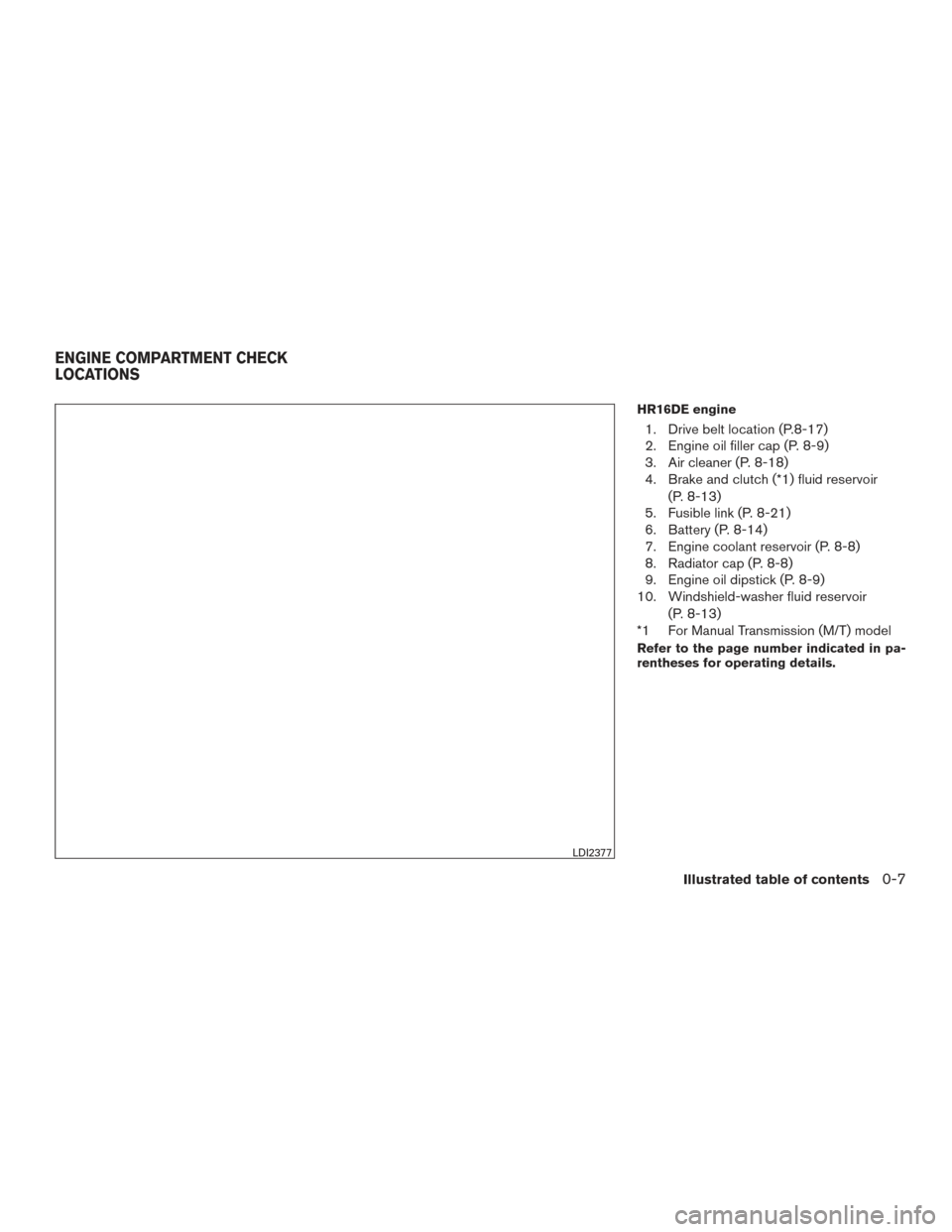
HR16DE engine
1. Drive belt location (P.8-17)
2. Engine oil filler cap (P. 8-9)
3. Air cleaner (P. 8-18)
4. Brake and clutch (*1) fluid reservoir(P. 8-13)
5. Fusible link (P. 8-21)
6. Battery (P. 8-14)
7. Engine coolant reservoir (P. 8-8)
8. Radiator cap (P. 8-8)
9. Engine oil dipstick (P. 8-9)
10. Windshield-washer fluid reservoir
(P. 8-13)
*1 For Manual Transmission (M/T) model
Refer to the page number indicated in pa-
rentheses for operating details.
LDI2377
ENGINE COMPARTMENT CHECK
LOCATIONS
Illustrated table of contents0-7
Page 15 of 384
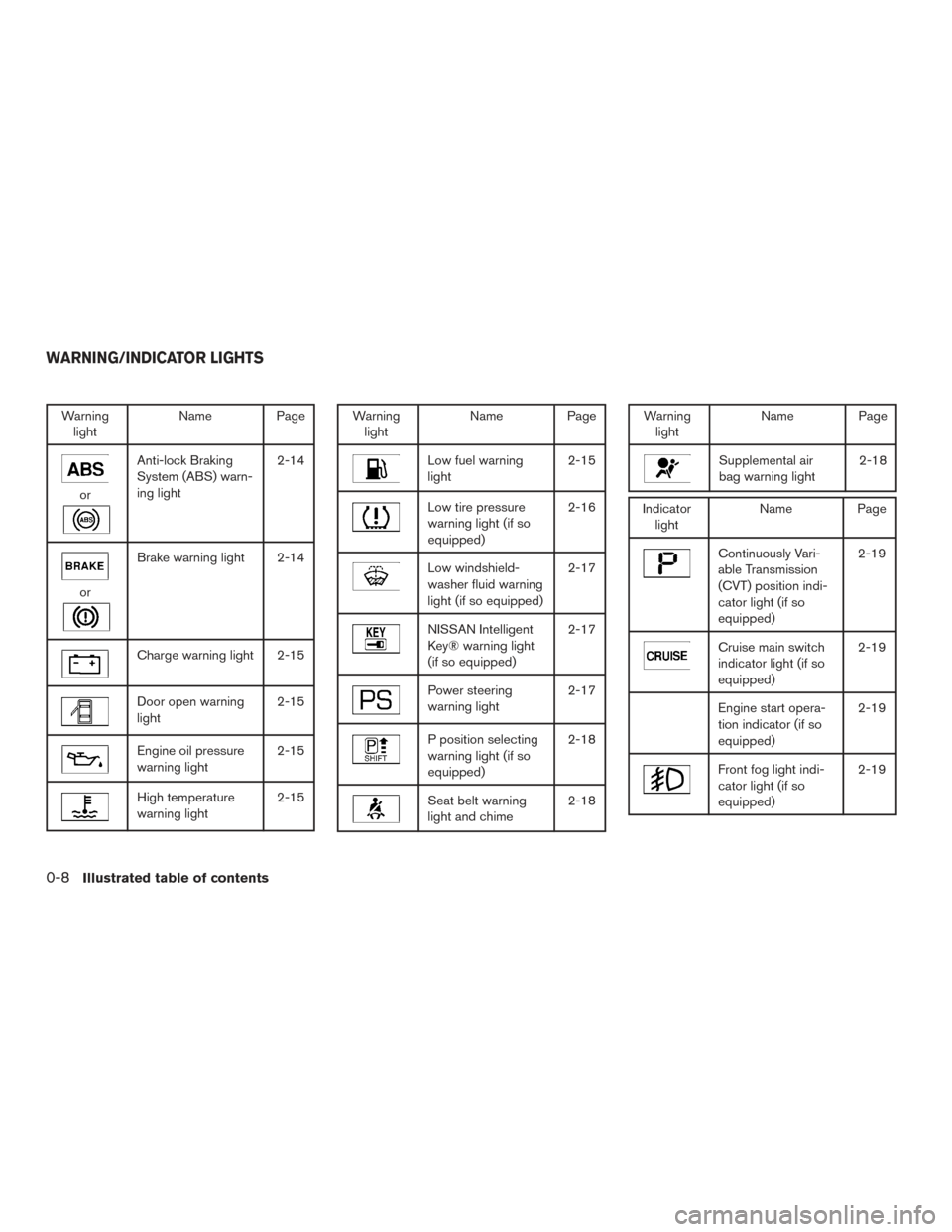
Warninglight Name Page
or
Anti-lock Braking
System (ABS) warn-
ing light 2-14
or
Brake warning light 2-14
Charge warning light 2-15
Door open warning
light
2-15
Engine oil pressure
warning light2-15
High temperature
warning light2-15
Warning
light Name Page
Low fuel warning
light 2-15
Low tire pressure
warning light (if so
equipped)2-16
Low windshield-
washer fluid warning
light (if so equipped)2-17
NISSAN Intelligent
Key® warning light
(if so equipped)2-17
Power steering
warning light
2-17
P position selecting
warning light (if so
equipped)2-18
Seat belt warning
light and chime
2-18
Warning
light Name Page
Supplemental air
bag warning light 2-18
Indicator
light Name Page
Continuously Vari-
able Transmission
(CVT) position indi-
cator light (if so
equipped) 2-19
Cruise main switch
indicator light (if so
equipped)
2-19
Engine start opera-
tion indicator (if so
equipped)2-19
Front fog light indi-
cator light (if so
equipped)2-19
WARNING/INDICATOR LIGHTS
0-8Illustrated table of contents
Page 78 of 384
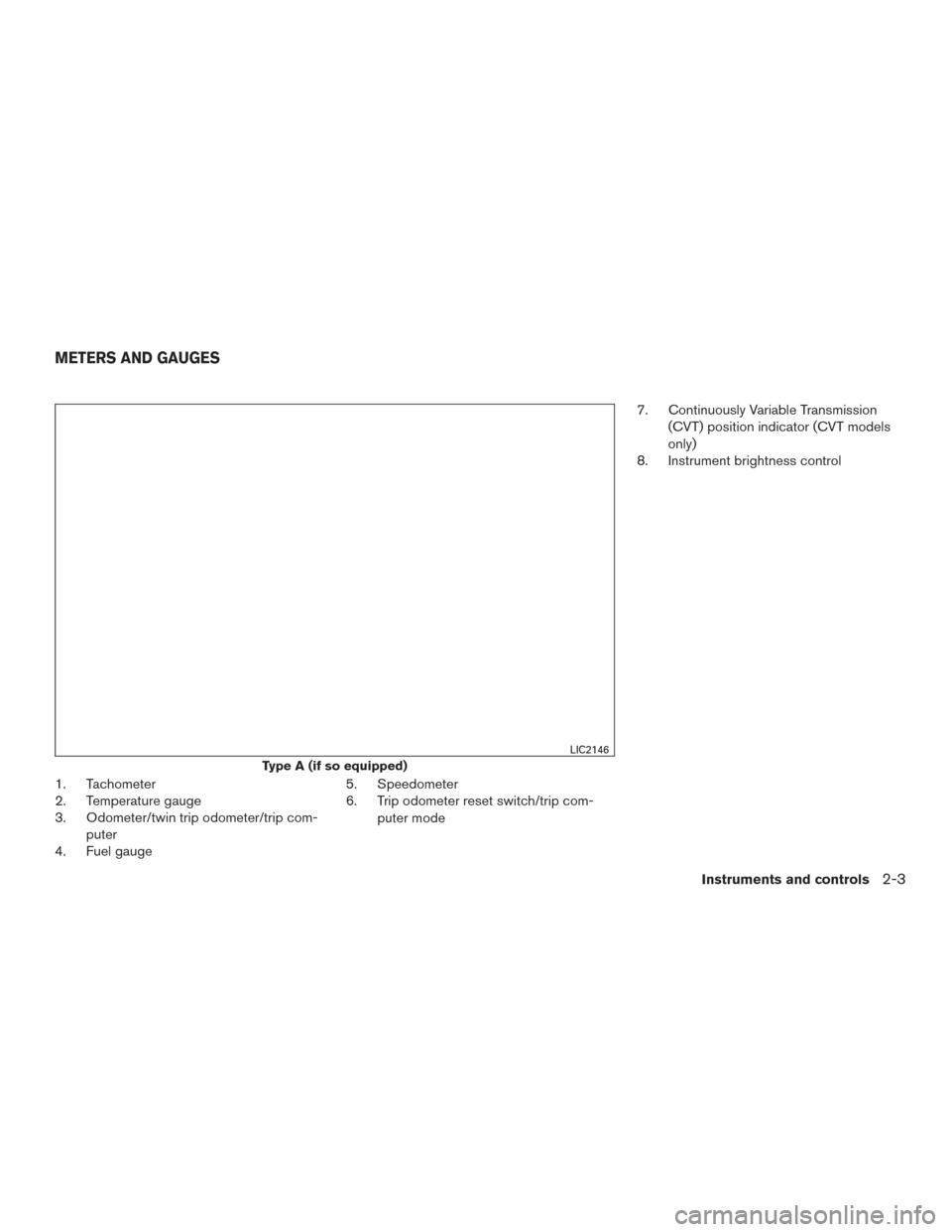
1. Tachometer
2. Temperature gauge
3. Odometer/twin trip odometer/trip com-puter
4. Fuel gauge 5. Speedometer
6. Trip odometer reset switch/trip com-
puter mode 7. Continuously Variable Transmission
(CVT) position indicator (CVT models
only)
8. Instrument brightness control
Type A (if so equipped)
LIC2146
METERS AND GAUGES
Instruments and controls2-3
Page 79 of 384
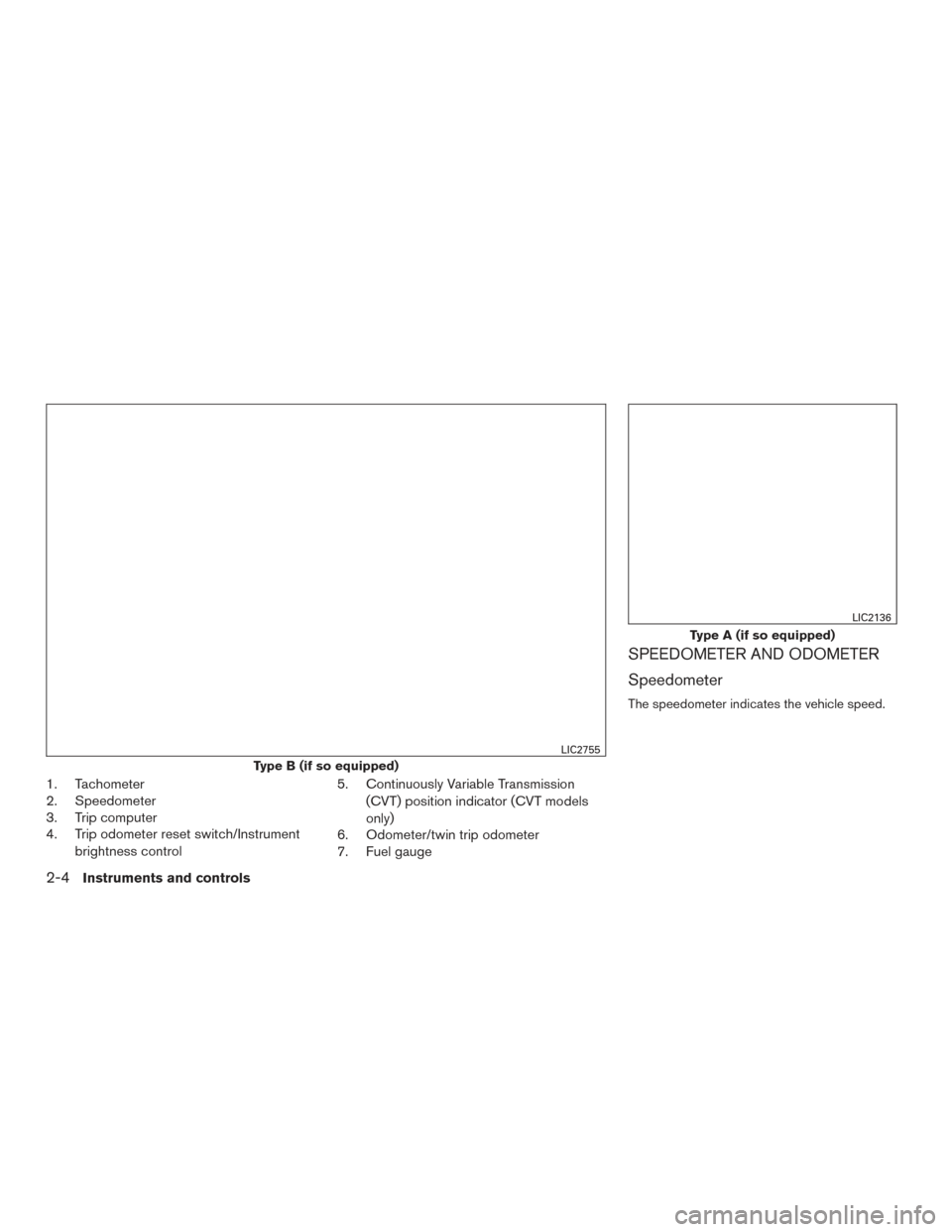
1. Tachometer
2. Speedometer
3. Trip computer
4. Trip odometer reset switch/Instrumentbrightness control 5. Continuously Variable Transmission
(CVT) position indicator (CVT models
only)
6. Odometer/twin trip odometer
7. Fuel gauge
SPEEDOMETER AND ODOMETER
Speedometer
The speedometer indicates the vehicle speed.
Type B (if so equipped)
LIC2755
Type A (if so equipped)
LIC2136
2-4Instruments and controls
Page 88 of 384

orAnti-lock Braking System (ABS)
warning lightNISSAN Intelligent Key® warning light
(if so equipped)Front passenger air bag status light
orBrake warning lightPower steering warning lightHigh beam indicator light (blue)
Charge warning lightP position selecting warning light
(if so equipped)Malfunction Indicator Light (MIL)
Door open warning lightSeat belt warning light and chimeOverdrive off indicator light (if so equipped)
Engine oil pressure warning lightSupplemental air bag warning lightSecurity indicator light (if so equipped)
High temperature warning lightContinuously Variable Transmission (CVT)
position indicator light (if so equipped)Side and headlight indicator light (green)
(if so equipped)
Low fuel warning lightCruise main switch indicator light
(if so equipped)Slip indicator light
Low tire pressure warning light
(if so equipped)Engine start operation indicator
(if so equipped)Turn signal/hazard indicator lights
Low windshield-washer fluid warning light
(if so equipped)Front fog light indicator light (if so equipped)Vehicle Dynamic Control (VDC) off indicator
light
WARNING/INDICATOR LIGHTS AND
AUDIBLE REMINDERS
Instruments and controls2-13
Page 94 of 384
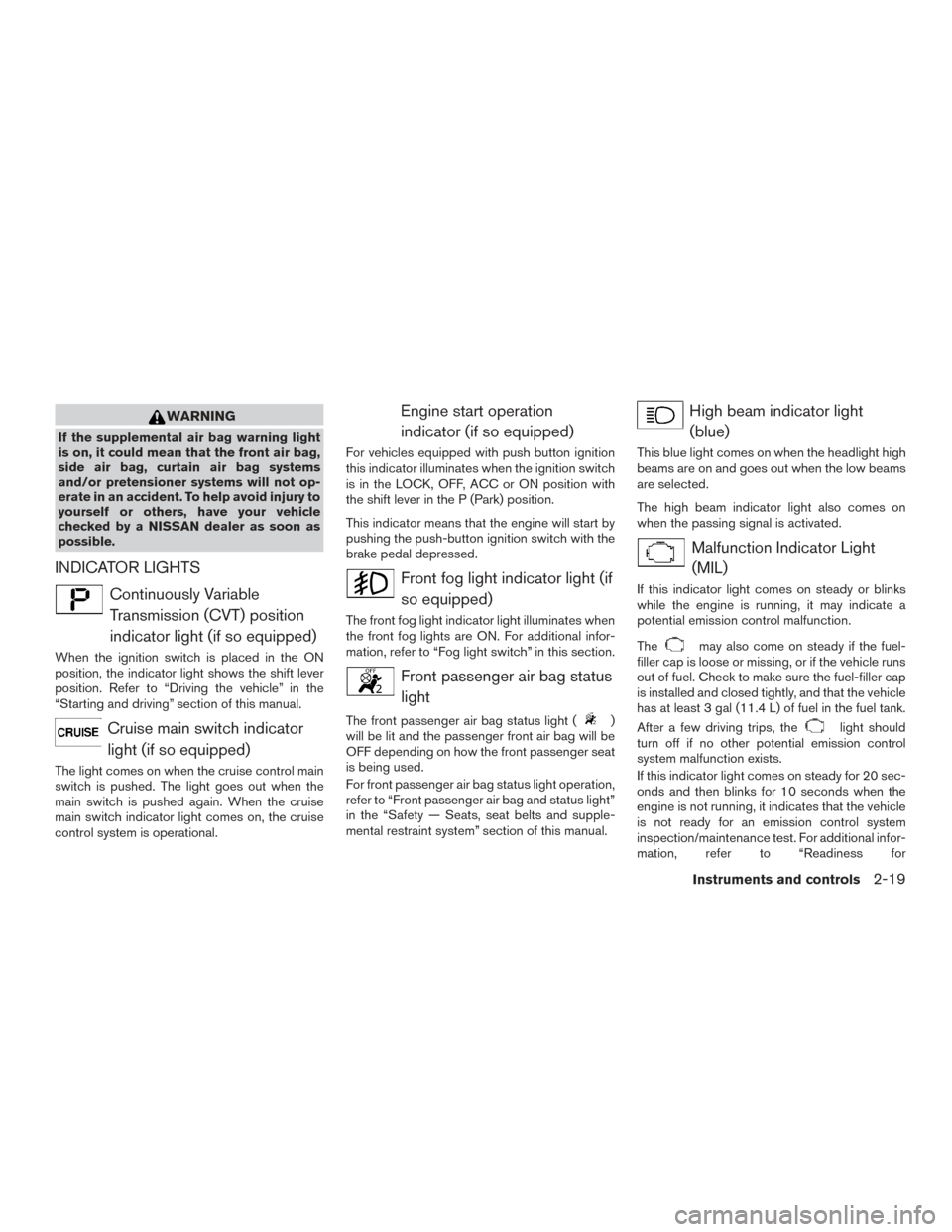
WARNING
If the supplemental air bag warning light
is on, it could mean that the front air bag,
side air bag, curtain air bag systems
and/or pretensioner systems will not op-
erate in an accident. To help avoid injury to
yourself or others, have your vehicle
checked by a NISSAN dealer as soon as
possible.
INDICATOR LIGHTS
Continuously VariableTransmission (CVT) position
indicator light (if so equipped)
When the ignition switch is placed in the ON
position, the indicator light shows the shift lever
position. Refer to “Driving the vehicle” in the
“Starting and driving” section of this manual.
Cruise main switch indicatorlight (if so equipped)
The light comes on when the cruise control main
switch is pushed. The light goes out when the
main switch is pushed again. When the cruise
main switch indicator light comes on, the cruise
control system is operational.
Engine start operationindicator (if so equipped)
For vehicles equipped with push button ignition
this indicator illuminates when the ignition switch
is in the LOCK, OFF, ACC or ON position with
the shift lever in the P (Park) position.
This indicator means that the engine will start by
pushing the push-button ignition switch with the
brake pedal depressed.
Front fog light indicator light (ifso equipped)
The front fog light indicator light illuminates when
the front fog lights are ON. For additional infor-
mation, refer to “Fog light switch” in this section.
Front passenger air bag statuslight
The front passenger air bag status light ()
will be lit and the passenger front air bag will be
OFF depending on how the front passenger seat
is being used.
For front passenger air bag status light operation,
refer to “Front passenger air bag and status light”
in the “Safety — Seats, seat belts and supple-
mental restraint system” section of this manual.
High beam indicator light
(blue)
This blue light comes on when the headlight high
beams are on and goes out when the low beams
are selected.
The high beam indicator light also comes on
when the passing signal is activated.
Malfunction Indicator Light(MIL)
If this indicator light comes on steady or blinks
while the engine is running, it may indicate a
potential emission control malfunction.
The
may also come on steady if the fuel-
filler cap is loose or missing, or if the vehicle runs
out of fuel. Check to make sure the fuel-filler cap
is installed and closed tightly, and that the vehicle
has at least 3 gal (11.4 L) of fuel in the fuel tank.
After a few driving trips, the
light should
turn off if no other potential emission control
system malfunction exists.
If this indicator light comes on steady for 20 sec-
onds and then blinks for 10 seconds when the
engine is not running, it indicates that the vehicle
is not ready for an emission control system
inspection/maintenance test. For additional infor-
mation, refer to “Readiness for
Instruments and controls2-19
Page 95 of 384
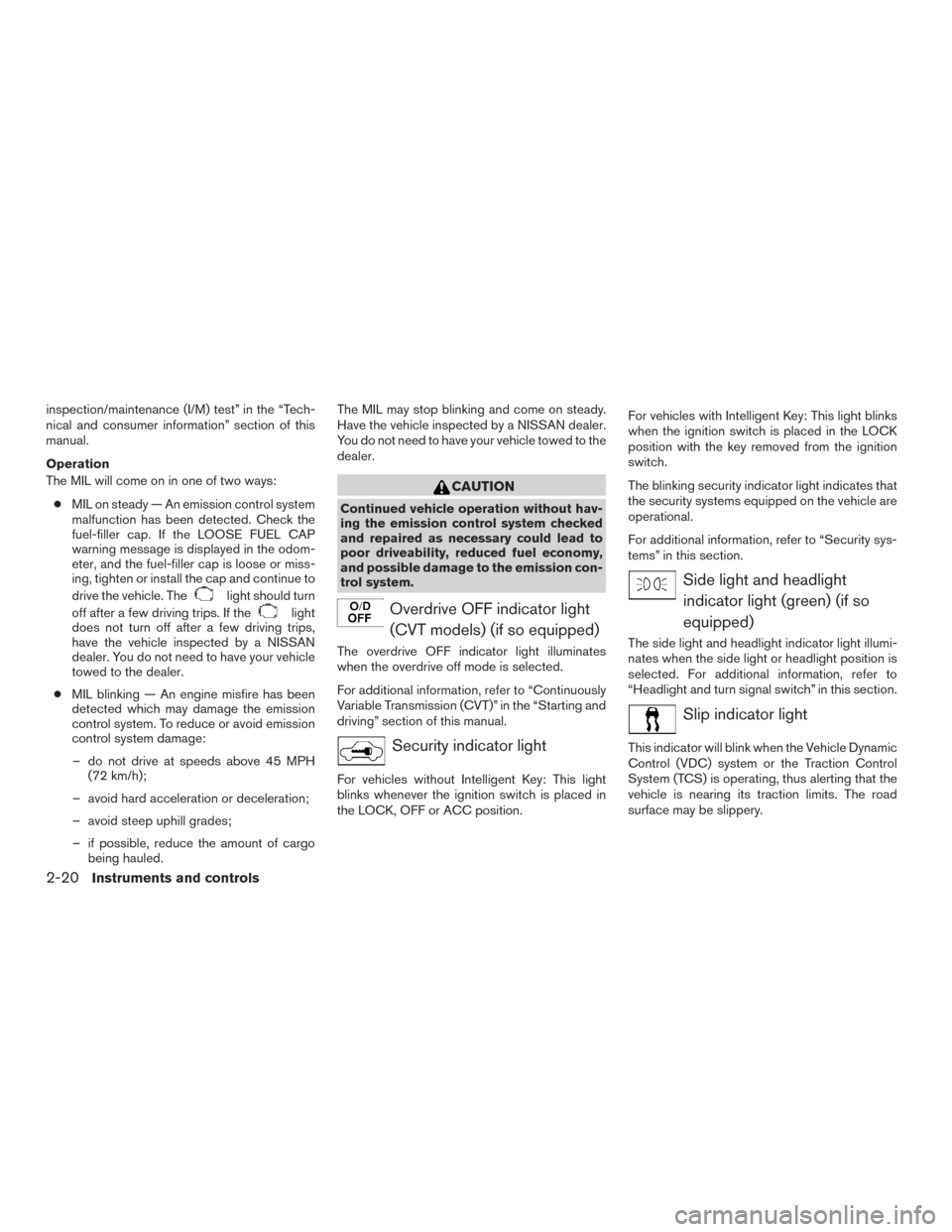
inspection/maintenance (I/M) test” in the “Tech-
nical and consumer information” section of this
manual.
Operation
The MIL will come on in one of two ways:● MIL on steady — An emission control system
malfunction has been detected. Check the
fuel-filler cap. If the LOOSE FUEL CAP
warning message is displayed in the odom-
eter, and the fuel-filler cap is loose or miss-
ing, tighten or install the cap and continue to
drive the vehicle. The
light should turn
off after a few driving trips. If the
light
does not turn off after a few driving trips,
have the vehicle inspected by a NISSAN
dealer. You do not need to have your vehicle
towed to the dealer.
● MIL blinking — An engine misfire has been
detected which may damage the emission
control system. To reduce or avoid emission
control system damage:
– do not drive at speeds above 45 MPH (72 km/h);
– avoid hard acceleration or deceleration;
– avoid steep uphill grades;
– if possible, reduce the amount of cargo being hauled. The MIL may stop blinking and come on steady.
Have the vehicle inspected by a NISSAN dealer.
You do not need to have your vehicle towed to the
dealer.
CAUTION
Continued vehicle operation without hav-
ing the emission control system checked
and repaired as necessary could lead to
poor driveability, reduced fuel economy,
and possible damage to the emission con-
trol system.
Overdrive OFF indicator light
(CVT models) (if so equipped)
The overdrive OFF indicator light illuminates
when the overdrive off mode is selected.
For additional information, refer to “Continuously
Variable Transmission (CVT)” in the “Starting and
driving” section of this manual.
Security indicator light
For vehicles without Intelligent Key: This light
blinks whenever the ignition switch is placed in
the LOCK, OFF or ACC position. For vehicles with Intelligent Key: This light blinks
when the ignition switch is placed in the LOCK
position with the key removed from the ignition
switch.
The blinking security indicator light indicates that
the security systems equipped on the vehicle are
operational.
For additional information, refer to “Security sys-
tems” in this section.
Side light and headlight
indicator light (green) (if so
equipped)
The side light and headlight indicator light illumi-
nates when the side light or headlight position is
selected. For additional information, refer to
“Headlight and turn signal switch” in this section.
Slip indicator light
This indicator will blink when the Vehicle Dynamic
Control (VDC) system or the Traction Control
System (TCS) is operating, thus alerting that the
vehicle is nearing its traction limits. The road
surface may be slippery.
2-20Instruments and controls
Page 253 of 384
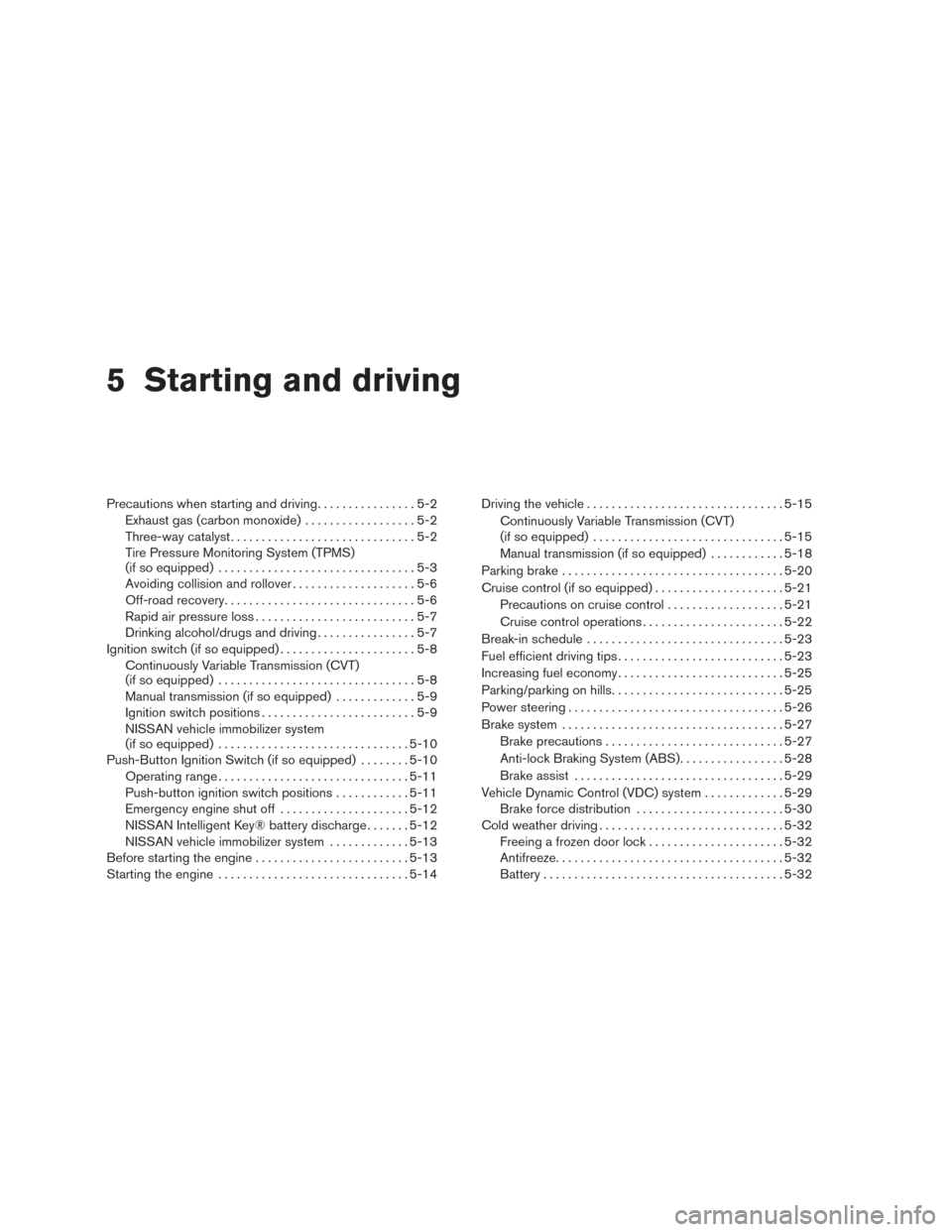
5 Starting and driving
Precautions when starting and driving................5-2
Exhaust gas (carbon monoxide) ..................5-2
Three-way catalyst ..............................5-2
Tire Pressure Monitoring System (TPMS)
(if so equipped) ................................5-3
Avoiding collision and rollover . . ..................5-6
Off-road recovery ...............................5-6
Rapid air pressure loss ..........................5-7
Drinking alcohol/drugs and driving ................5-7
Ignition switch (if so equipped) ......................5-8
Continuously Variable Transmission (CVT)
(if so equipped) ................................5-8
Manual transmission (if so equipped) .............5-9
Ignition switch positions .........................5-9
NISSAN vehicle immobilizer system
(if so equipped) ............................... 5-10
Push-Button Ignition Switch (if so equipped) ........5-10
Operating range ............................... 5-11
Push-button ignition switch positions . . . .........5-11
Emergency engine shut off .....................5-12
NISSAN Intelligent Key® battery discharge .......5-12
NISSAN vehicle immobilizer system .............5-13
Before starting the engine ......................... 5-13
Starting the engine ............................... 5-14Driving the vehicle
................................ 5-15
Continuously Variable Transmission (CVT)
(if so equipped) ............................... 5-15
Manual transmission (if so equipped) ............5-18
Parking brake .................................... 5-20
Cruise control (if so equipped) . . ...................5-21
Precautions on cruise control ...................5-21
Cruise control operations .......................5-22
Break-in schedule ................................ 5-23
Fuel efficient driving tips ........................... 5-23
Increasing fuel economy ........................... 5-25
Parking/parking on hills ............................ 5-25
Power steering ................................... 5-26
Brake system .................................... 5-27
Brake precautions ............................. 5-27
Anti-lock Braking System (ABS) .................5-28
Brake assist .................................. 5-29
V
ehicle Dynamic Control (VDC) system .............5-29
Brake force distribution ........................ 5-30
Cold weather driving .............................. 5-32
Freeing a frozen door lock ......................5-32
Antifreeze ..................................... 5-32
Battery ....................................... 5-32